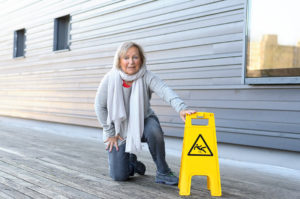
Yes, that’s right. Winter is coming. So you better be ready.
One thing that goes hand in hand with winter months is the increased risk of a slip and fall accident. Let’s say you do slip and fall on a patch of ice on the steps of a local convenience store. If you follow this blog regularly, you know that the store is likely responsible for your accident since the owners and/or employees had failed to clean up the ice patch before you entered the store. But to build your case correctly, you will need proof that shows negligence. But how?
Building a Slip and Fall Accident Case
Commerical property owners have a responsibility to make sure their property is free of hazards that could cause injury to those who visit the store. And when they fail in their duty, then not only will you be injured, but it opens up a premises liability case against that owner. But how can you prove the slip and fall accident was the owner’s fault?
The first thing you will need is to show that negligence by the owner was the cause of your accident. Sounds simple enough but can be rather complicated. In lawsuits like this, it’s always a “He Said, She Said” case. And that’s why it’s extremely important to get the evidence needed to support your claim.
Slip and Fall Questions to Ask
So let’s look at our example. You slipped and fell on a patch of ice at a convenience store. How is the store responsible for your fall? The owner can always argue that you weren’t paying attention or the employees were unaware of the hazard. This is when you need the answers to the following questions:
- Was the owner/employees aware of the hazard? For example, let’s say it was an extremely cold day and it had rained the night before. With such a change in temperature, shouldn’t the owner have known that ice would form on the steps? It is here that mode of operation rule will come into play.
- Did the owner/employees take steps to fix the hazard? Were there signs around warning of the hazard? Did it look like someone had tried to clean up the ice before the accident? Try to take photos of the accident scene if you can to show if anything had been done to fix the hazard prior to your accident.
- Did the owner/employees cause the hazard? Let’s change the location of where the hazard was. Let’s say an employee had dropped a bottle of water in one of the store aisles and didn’t clean it up.
- Was there enough time prior to the accident to fix the hazard? Timing is key in these types of accidents. If it just snowed, for example, there may not have been enough time for the owner or employees to clean up the hazard before the accident.
Contact an Experienced Slip and Fall Attorney Today
It’s important that you have all the evidence needed to build a successful slip and fall case. And your best option after a slip and fall accident is to contact the Law Offices of Anthony Carbone as soon as possible. Our slip and fall attorney will help you win your case. Call today!